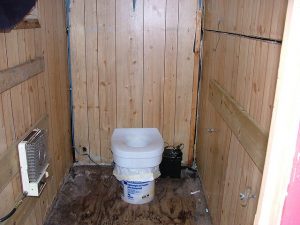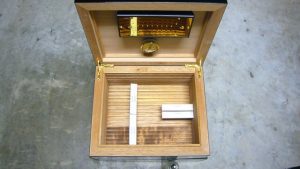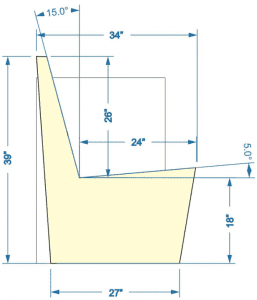As surprising as it may sound, chickens get cold. At least, they get cold if you happen to live in a part of the country where it gets cold in the winter. Actually, all animals struggle with cold winter weather, just the same as we do. Therefore, if we have those animals, we need to figure out how to keep them warm, when the sun isn’t doing it for us.
Most people opt for using electric heat to keep their chickens warm; either in the form of heat lamps or by installing electric heaters. Chickens can’t throw another log on the fire, so the electric heaters make a lot more sense than installing a fireplace, but electric heat is expensive, raising the overall cost of your eggs or fryers.
I’ve seen a few people try to solve this problem by putting solar panels on their chicken coops, generating electricity to run their heaters. But that’s inherently very inefficient. First of all, electric heat is inefficient, and the loss of converting sunlight to electric power and then to heat is enormous. Besides, you can’t put enough solar panels on the average chicken coop to run the heaters; so your chickens aren’t going to get enough heat that way.
That’s not to say that sunlight is out though. Solar power can be used much more directly for heating, than by converting it to electricity. Passive solar heating is not only very efficient, producing a fair amount of heat, but is easy to add to just about any structure, including a chicken coop.
The Basics of Passive Solar
If you leave a black sweater sitting on the bed, where the sun shining through the window shines on it, the sweater will get hot. This is passive solar on its most basic level; sunlight coming through the window hits the sweater and is absorbed by it, being converted to heat in the process. Because the sweater is black, more of the sunlight is absorbed, producing more heat. The material of the sweater, as well as the bed underneath it, absorbs some of that heat, saving it for later.
In a home, a true passive solar system looks something like this:
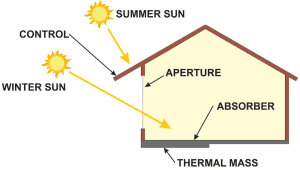
As you can see, we have the same elements, although in this drawing they have the correct names. The window that the sun is shining through is called the “aperture,” the black sweater is the “absorber” and the bed that holds the heat in is the “thermal mass.” One other element is added, the roof overhang, called the “control” which keeps the summer sun from shining in and heating up the sweater.
The absorber in the diagram needs to be a dark color, preferably black. The darker the color, the more sunlight it will absorb, converting it to heat. Light colors reflect a lot of light, so won’t generate much heat. In a home, like the one shown above, the thermal mass is usually rock or concrete, which holds heat well and will radiate it into the home at night.
Applying that to a Chicken Coop
In order to make a chicken coop passive solar, we’ll need to add a glass wall (window) on the south side of the coop. This should be pointing as straight south as possible, so use a compass to make sure your coop is aligned properly. If you are building a chicken coop, you can make the south-facing wall of the chicken coop the aperture, but if you’re modifying an existing coop, you’ll need to add onto it, giving it something along the lines of a “sun room.”
An important part of this is getting the aperture at the right angle. A vertical window is actually not ideal. While that will work, you’re going to get the most sunlight into the solar heating part of your chicken coop if you angle the aperture to match the sun, based upon the latitude you live at:
Latitude | Angle from Horizontal | Angle from Vertical |
|---|---|---|
| 30° | 56° | 34° |
| 35° | 60.5° | 29.5° |
| 40° | 65° | 25° |
| 45° | 69.5° | 20.5° |
While the sun’s angle in the sky will vary throughout the year, this is the angle necessary for the aperture to be pointing directly at the sun’s track in the wintertime, which is when your chickens need the heat the most.
Our other big problem is that of the thermal mass, which needs to be directly connected to the absorber. Since this is a chicken coop, concrete isn’t practical; so we’re going to borrow an idea that gardeners use in their greenhouses, modifying the idea slightly.
It’s not uncommon to see black plastic barrels, filled with water, sitting around in greenhouses. These aren’t actually there to provide water for the plants. Any greenhouse is a passive solar structure and those barrels are absorbers. The water inside them is acting as a thermal mass, storing the heat generated by the sun hitting the black plastic, and then releasing that heat at night, when the temperature drops.
We can’t fit a black plastic barrel in our chicken coop, but we can fit black plastic bottles. All we need to do is save bottles from motor oil, transmission fluid and power steering fluid, taking care to buy brands which come in black plastic bottles, rather than other colors. With a little work, we can remove the labels from these, giving us something to use for a thermal mass.
Rather than filling the bottles with water, it would actually be more effective to fill them with oil, specifically used motor oil, which is often a disposal problem. The oil will hold more heat than water will and will not expand from freezing, splitting the container, like water does.
Making the Solar Chicken Coop
Now that we’ve got our plan in place, how are we going to make the chicken coop?
Basically, all we need for this is a plywood frame and a glass window. If you happen to have a used window around or know someone who does, that’s great. But if not, you can buy a piece of glass or Plexiglas at your local building materials center.
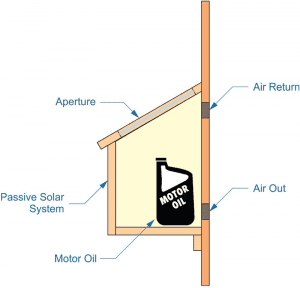
All we need, to make this work, is a box to hang on the side of the chicken coop, the longer the better. This box can be made out of ½” plywood, particle board, chip board or MDF, depending on what you have available. Just be sure to paint it well, taking extra care to seal the ends of the boards, so that moisture will not wick into the boards.
As you can see in the diagram above, the aperture is in the “roof” of this box, angling it towards the sun. It is also necessary to cut slots or holes in the side of the chicken coop, at the top of the solar heating system and at the bottom, for air to circulate from the chicken coop, into the solar heater and back out again. Insulating the inside of the chicken coop and the solar heater would be good, as well, so as to hold the heat inside. You should also paint the inside of the solar heater flat black, so that it will absorb as much sunlight as possible, converting it to heat.
I would put as many filled oil container inside the solar heater as you can, so as to absorb and store the most possible heat for use in keeping your chickens warm at night. That’s when they’ll need the heat the most, so the heat stored in that thermal mass is important.


